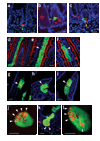Bmi1 is expressed in vivo in intestinal stem cells
- PMID: 18536716
- PMCID: PMC2906135
- DOI: 10.1038/ng.165
Bmi1 is expressed in vivo in intestinal stem cells
Abstract
Bmi1 plays an essential part in the self-renewal of hematopoietic and neural stem cells. To investigate its role in other adult stem cell populations, we generated a mouse expressing a tamoxifen-inducible Cre from the Bmi1 locus. We found that Bmi1 is expressed in discrete cells located near the bottom of crypts in the small intestine, predominantly four cells above the base of the crypt (+4 position). Over time, these cells proliferate, expand, self-renew and give rise to all the differentiated cell lineages of the small intestine epithelium. The induction of a stable form of beta-catenin in these cells was sufficient to rapidly generate adenomas. Moreover, ablation of Bmi1(+) cells using a Rosa26 conditional allele, expressing diphtheria toxin, led to crypt loss. These experiments identify Bmi1 as an intestinal stem cell marker in vivo. Unexpectedly, the distribution of Bmi1-expressing stem cells along the length of the small intestine suggested that mammals use more than one molecularly distinguishable adult stem cell subpopulation to maintain organ homeostasis.
Figures






Comment in
-
A new identity for the elusive intestinal stem cell.Nat Genet. 2008 Jul;40(7):818-9. doi: 10.1038/ng0708-818. Nat Genet. 2008. PMID: 18583974 No abstract available.
References
-
- Wagers AJ, Weissman IL. Plasticity of adult stem cells. Cell. 2004;116:639–648. - PubMed
-
- Seaberg RM, van der Kooy D. Stem and progenitor cells: the premature desertion of rigorous definitions. Trends Neurosci. 2003;26:125–131. - PubMed
-
- Shackleton M, et al. Generation of a functional mammary gland from a single stem cell. Nature. 2006;439:84–88. - PubMed
-
- Ahn S, Joyner AL. In vivo analysis of quiescent adult neural stem cells responding to Sonic hedgehog. Nature. 2005;437:894–897. - PubMed
-
- Lessard J, Sauvageau G. Bmi-1 determines the proliferative capacity of normal and leukaemic stem cells. Nature. 2003;423:255–260. - PubMed
Publication types
MeSH terms
Substances
Grants and funding
LinkOut - more resources
Full Text Sources
Other Literature Sources
Molecular Biology Databases
Research Materials

